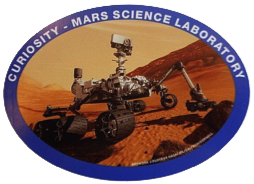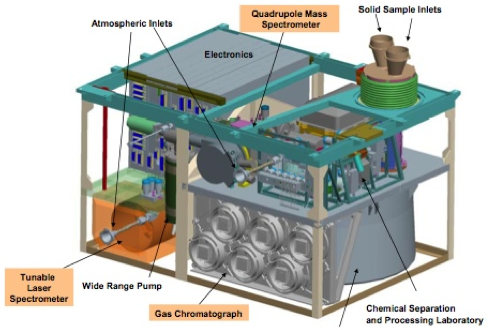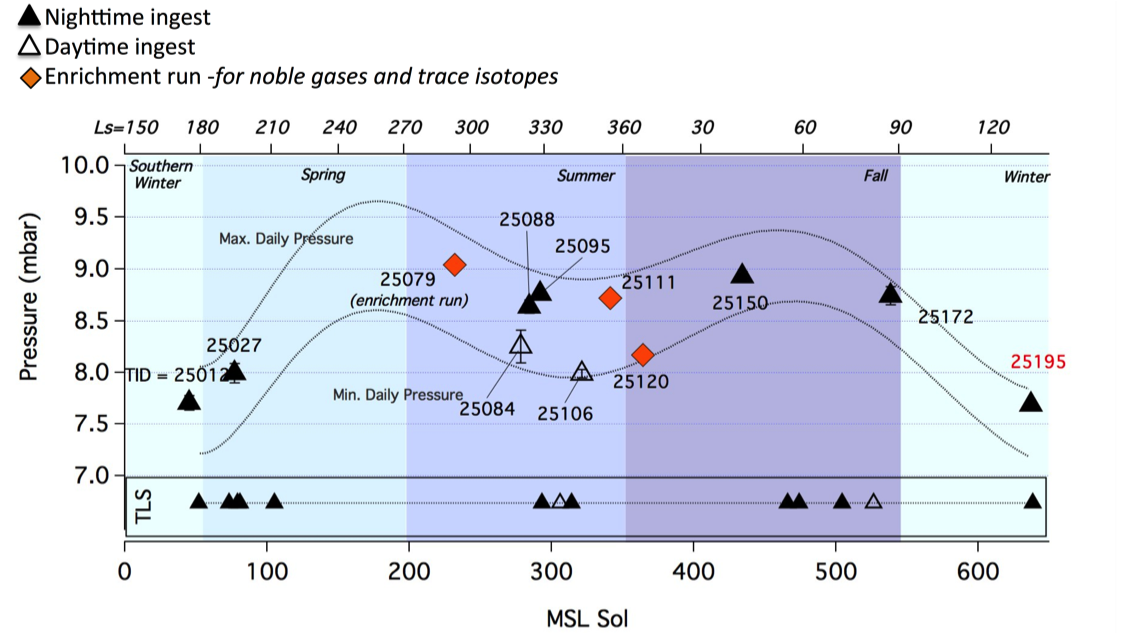
Sep 3, 2013 (Ls 165.2 MY 31) to [ongoing]

This illustration of SAM highlights its three main instruments. Photo Credit: NASA/JPL/Goddard Space Flight Center.
Sample Analysis at Mars (SAM)
SAM was designed to address the present and past habitability of Mars by exploring molecular and elemental chemistry relevant to life. The SAM suite includes a Quadrupole Mass Spectrometer (QMS), a Gas Chromatograph (GC), and a Tunable Laser Spectrometer (TLS). The laser spectrometer is used to measure isotope abundances in the atmosphere. A timetable of SAM's atmospheric measurements is included below.
SAM Archive (you will be redirected to the SAM archive housed within PDS's Geosciences Node at Washington University in St. Louis, MO).
SAM Data Descriptions:
Level 0 (Raw Data Numbers) Data Set Description Document
Level 1A (Calibrated) Data Set Description Document
Level 1B (Corrected) Data Set Description Document
Level 2 (Composition and Abundance) Data Set Description Document
Level 1A (Calibrated) Data Set Description Document
Level 1B (Corrected) Data Set Description Document
Level 2 (Composition and Abundance) Data Set Description Document
SAM Archive (you will be redirected to the SAM archive housed within PDS's Geosciences Node at Washington University in St. Louis, MO).
CERTIFIED
Tabular Timetable of SAM atmospheric measurements: .XLSX .CSV .PDF
SAM Atmospheric Measurements for sols 0 to 550
 SAM Atmospheric QMS experiments are plotted with the atmospheric pressure measurement taken by REMS at or near time of ingestion (left axis) as a function of MSL mission sol (bottom axis) and solar longitude (top axis). The experiments are identified by their test identification number ("TID") and type (nighttime, daytime, and enrichment run). The background is shaded by southern season, and the REMS daily pressure maximum and minimum values are given by the dotted lines. Seasonal trends are tracked through the direct atmospheric runs, with attention paid to possible diurnal variations. Enrichment runs, performed at night, provide sensitive atmospheric noble gas measurements and insight on long-term temporal trends, but do not inform seasonal mixing ratio data as the major components of the atmosphere were scrubbed. Courtesy of Dr. Melissa Trainer, Goddard Spaceflight Center.
SAM Atmospheric QMS experiments are plotted with the atmospheric pressure measurement taken by REMS at or near time of ingestion (left axis) as a function of MSL mission sol (bottom axis) and solar longitude (top axis). The experiments are identified by their test identification number ("TID") and type (nighttime, daytime, and enrichment run). The background is shaded by southern season, and the REMS daily pressure maximum and minimum values are given by the dotted lines. Seasonal trends are tracked through the direct atmospheric runs, with attention paid to possible diurnal variations. Enrichment runs, performed at night, provide sensitive atmospheric noble gas measurements and insight on long-term temporal trends, but do not inform seasonal mixing ratio data as the major components of the atmosphere were scrubbed. Courtesy of Dr. Melissa Trainer, Goddard Spaceflight Center.
 SAM Atmospheric QMS experiments are plotted with the atmospheric pressure measurement taken by REMS at or near time of ingestion (left axis) as a function of MSL mission sol (bottom axis) and solar longitude (top axis). The experiments are identified by their test identification number ("TID") and type (nighttime, daytime, and enrichment run). The background is shaded by southern season, and the REMS daily pressure maximum and minimum values are given by the dotted lines. Seasonal trends are tracked through the direct atmospheric runs, with attention paid to possible diurnal variations. Enrichment runs, performed at night, provide sensitive atmospheric noble gas measurements and insight on long-term temporal trends, but do not inform seasonal mixing ratio data as the major components of the atmosphere were scrubbed. Courtesy of Dr. Melissa Trainer, Goddard Spaceflight Center.
SAM Atmospheric QMS experiments are plotted with the atmospheric pressure measurement taken by REMS at or near time of ingestion (left axis) as a function of MSL mission sol (bottom axis) and solar longitude (top axis). The experiments are identified by their test identification number ("TID") and type (nighttime, daytime, and enrichment run). The background is shaded by southern season, and the REMS daily pressure maximum and minimum values are given by the dotted lines. Seasonal trends are tracked through the direct atmospheric runs, with attention paid to possible diurnal variations. Enrichment runs, performed at night, provide sensitive atmospheric noble gas measurements and insight on long-term temporal trends, but do not inform seasonal mixing ratio data as the major components of the atmosphere were scrubbed. Courtesy of Dr. Melissa Trainer, Goddard Spaceflight Center.
 PDS: The Planetary Atmospheres Node
PDS: The Planetary Atmospheres Node

